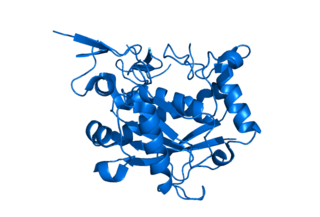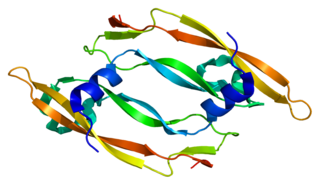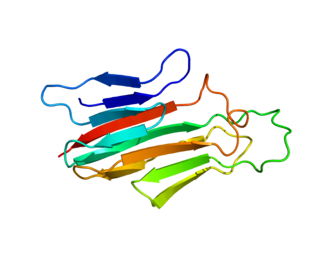
Angiopoietin is part of a family of vascular growth factors that play a role in embryonic and postnatal angiogenesis. Angiopoietin signaling most directly corresponds with angiogenesis, the process by which new arteries and veins form from preexisting blood vessels. Angiogenesis proceeds through sprouting, endothelial cell migration, proliferation, and vessel destabilization and stabilization. They are responsible for assembling and disassembling the endothelial lining of blood vessels. Angiopoietin cytokines are involved with controlling microvascular permeability, vasodilation, and vasoconstriction by signaling smooth muscle cells surrounding vessels. There are now four identified angiopoietins: ANGPT1, ANGPT2, ANGPTL3, ANGPT4.

Angiopoietin 1 is a type of angiopoietin and is encoded by the gene ANGPT1.

Angiopoietin-2 is a protein that in humans is encoded by the ANGPT2 gene.

G-protein coupled receptor 4 is a protein that in humans is encoded by the GPR4 gene.

Prokineticin receptor 1, also known as PKR1, is a human protein encoded by the PROKR1 gene.

Chemokine-binding protein 2 is a protein that in humans is encoded by the CCBP2 gene.

A disintegrin and metalloproteinase with thrombospondin motifs 1 is an enzyme that in humans is encoded by the ADAMTS1 gene.

Angiopoietin-like 4 is a protein that in human is encoded by the ANGPTL4 gene. Alternatively spliced transcript variants encoding different isoforms have been described. This gene was previously referred to as ANGPTL2, HFARP, PGAR, or FIAF but has been renamed ANGPTL4.

Chloride intracellular channel 4, also known as CLIC4, is a eukaryotic gene.

Angiopoietin-related protein 1 also known as angiopoietin-3 (ANG-3) is a protein that in humans is encoded by the ANGPTL1 gene.

Vascular endothelial growth factor B also known as VEGF-B is a protein that, in humans, is encoded by the VEGF-B gene. VEGF-B is a growth factor that belongs to the vascular endothelial growth factor family, of which VEGF-A is the best-known member.

Fibrinogen-like protein 2, also known as FGL2, is a protein which in humans is encoded by the FGL2 gene.

Angiopoietin-like 3, also known as ANGPTL3, is a protein that in humans is encoded by the ANGPTL3 gene.

Angiopoietin-4 is a protein that in humans is encoded by the ANGPT4 gene.

Tumor necrosis factor ligand superfamily member 18 is a protein that in humans is encoded by the TNFSF18 gene.

Angiopoietin-related protein 7 is a protein that in humans is encoded by the ANGPTL7 gene.

Myoferlin is a protein that in humans is encoded by the MYOF gene.

Actin-like protein 7A is a protein that in humans is encoded by the ACTL7A gene.

Cadherin 10 is a protein that in humans is encoded by the CDH10 gene.

ANGPTL8 is a protein that in humans is encoded by the C19orf80 gene.





















